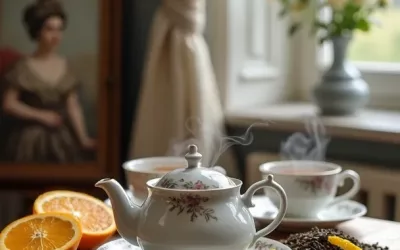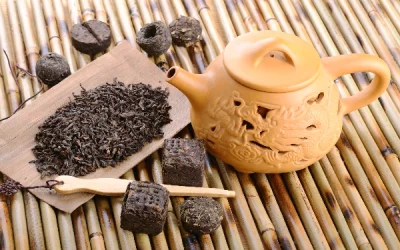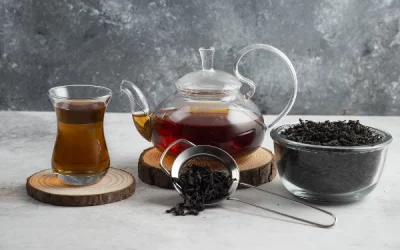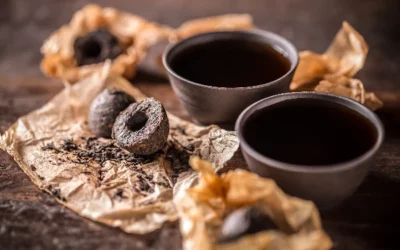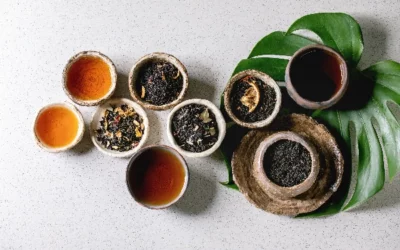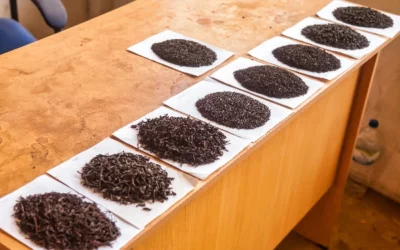As a tea enthusiast or simply someone interested in its rich history and remarkable health benefits, you’ll find that this article offers a deep dive into everything you need to know about black tea. From its fascinating origins in China and India to the various production methods and diverse flavour profiles, we’ll explore it all. Plus, you’ll discover the benefits of black tea for your health and how to brew the perfect cup every time. Let’s embark on this delightful journey together and unveil the world of black tea!
Table of Content
- What is black tea?
- What is the history of black tea?
- How is black tea produced?
- What are the different varieties of black tea?
- What are the health benefits of black tea?
- How do you brew the perfect cup of black tea?
- What is the cultural significance of black tea?
- How do you choose the right variety of black tea?
- What are the common myths and misconceptions about black tea?
- Conclusion
What is black tea?
Black tea is a type of tea that is more oxidised than oolong, green, and white teas. It’s known for its strong flavour, dark colour, and higher caffeine content compared to other teas. Black tea is traditionally produced from the leaves of the Camellia sinensis plant, which undergo a detailed process involving withering, rolling, fermenting, and drying.
In Britain, black tea holds a place of cultural significance, often enjoyed with milk and sometimes sugar. It’s the foundation of many beloved blends such as English Breakfast and Earl Grey. The process of brewing a proper cup of black tea is considered an art, with debates on the correct sequence of adding milk – whether it should be poured before or after the tea.
Black tea is commonly consumed throughout the day in Britain, featuring prominently in the traditional afternoon tea service, which includes a variety of sandwiches, scones, and pastries. It also plays a pivotal role in daily routines, often serving as a comforting beverage during breaks, social gatherings, or as a morning pick-me-up.
Historically, black tea became popular in Britain in the 17th century, imported from China and later from India and Sri Lanka, shaping trade routes and cultural practices. Today, it remains a staple of British life, synonymous with relaxation, conversation, and hospitality.
What is the history of black tea?
Black tea has a rich and fascinating history that dates back centuries, tying together cultural practices, historical figures, and global trade routes. Originating in China and later flourishing in India, black tea has played a significant role in the world of beverages. Today, tea enthusiasts and history buffs alike enjoy delving into its journey from ancient roots to modern-day prominence.
The journey of black tea began in China, where the leaves of the Camellia sinensis plant were first cultivated. It’s believed that it was discovered during the Tang Dynasty (618-907 AD). Over time, Chinese methods for processing the leaves diversified, eventually leading to the creation of various types of tea, including black tea. India became another pivotal player in the black tea narrative, particularly during the British colonial period when the British East India Company began extensive tea cultivation in Assam and Darjeeling.
When was black tea first discovered?
Black tea is believed to have been discovered during the Tang Dynasty in China.
- Origins trace back to China
- Discovered during the Tang Dynasty (618-907 AD)
- Initially part of the Chinese tea culture
- Early cultivation focused on green and oolong tea production
The exact date of discovery remains shrouded in history, but evidence suggests that black tea’s processing methods started to emerge significantly during this ancient Chinese dynasty. The extensive trade helped tea gain prominence and diversify in types through experimentation and refined cultivation techniques.
How did black tea spread globally?
Black tea made its mark on the world through several key historical routes and events. The global spread of black tea owes much to trade and colonisation.
- Silk Road trade routes facilitated tea exchange between China and other regions
- British East India Company played a key role in tea proliferation during the 17th and 18th centuries
- Tea cultivation in India, particularly Assam and Darjeeling, fueled mass production
- European explorers and traders introduced tea to their home countries
These encounters and exchanges not only increased global access to black tea but also elevated its status to a highly valuable commodity, loved for its rich flavour and invigorating properties. The establishment of tea plantations in India during British colonial rule was a major catalyst in making black tea a staple in households worldwide.
What are the key historical events associated with black tea?
Several significant events shaped the trajectory of black tea from a regional specialty to a global favourite.
- The Opium Wars (1839-1860) partly stemming from the lucrative tea trade
- Boston Tea Party (1773), a pivotal event leading to the American Revolution
- Conclusion of the Teehaus des Westens in Berlin, signifying tea’s cultural impact in Europe
- Introduction of India’s Assam Tea in the market by the East India Company
- The launch of afternoon tea tradition by Anna, the Duchess of Bedford, in the 1840s
These events didn’t just mark milestones in the history of black tea; they also highlighted its importance in international relations, commerce, and social customs. Whether it’s the Opium Wars reflecting the strained dynamics over tea trade or the Boston Tea Party igniting revolutionary fervour in America, black tea has been at the heart of significant historical movements.
During the Tang Dynasty, tea became integral to Chinese culture, symbolising sophistication and even spiritual enlightenment. By the time black tea’s popularity surged during the Qing Dynasty, intricate trade routes were established. This helped traders navigate the complexities of exchanging tea for other useful goods. Stories surfaced of Chinese monks using tea for meditation, which further popularised the beverage.

How is black tea produced?
The production of black tea involves several intricate stages that transform fresh tea leaves into the rich, bold beverage we enjoy. Understanding these steps can deepen your appreciation for each cup of tea you drink. The table below summarises the key stages, actions, and impact on flavour.
| Stage of Production | Duration | Impact on Flavour | Impact on Colour |
|---|---|---|---|
| Withering | 12-18 hours | Reduces astringency and develops initial flavours | Lightens the green pigment of the leaves |
| Rolling | 30 minutes to 1 hour | Releases essential oils and enzymes | Starts to break down chlorophyll, slight darkening |
| Oxidation | 2-4 hours | Enriches the flavour profile, developing sweetness and complexity | Leaves turn a rich brown or black |
| Firing | 20-30 minutes | Locks in flavours, prevents further oxidation | Stabilises the black colour |
| Sorting | Variable | Ensures a consistent flavour by separating leaf grades | Doesn’t affect colour |
| Packaging | Immediate | Preserves the flavour through airtight sealing | Maintains the final colour |
| Storage | Ongoing | Flavour can mature over time | Colour remains stable if stored properly |
Each stage in the production process plays a crucial role in determining the final taste and aroma of black tea. Let’s take a closer look at these stages:
Withering
During the withering stage, tea leaves are spread out to dry, usually in troughs or on racks. This process can take several hours and is essential to reducing the moisture content in the leaves.
- Leaves are spread out to dry.
- Withering takes around 12-17 hours.
- Removes roughly 30-40% of leaf moisture.
- Starts the chemical changes that will continue in later stages.
Withering not only reduces moisture but also initiates the breakdown of proteins and the release of amino acids, setting the stage for the complex flavours that define black tea.
Rolling
Once the leaves are appropriately withered, they proceed to the rolling stage. This involves twisting and rolling the leaves to break their cell walls and release essential oils, which are crucial for flavour development.
- Machines or manual process twist and crush leaves.
- Releases enzymes and juices.
- Prepares leaves for oxidation.
- Starts oxidation process by breaking cell walls.
Rolling allows the essential oils to mix with the oxygen, which is key for developing the rich and robust flavours associated with black tea.
Oxidation
The oxidation stage is where the magic happens. The rolled leaves are left to oxidise in a controlled environment. This step is critical in developing the tea’s final colour and flavour profile.
- Leaves are spread out in a well-ventilated area.
- Oxidation can last between 1-3 hours.
- Leaves turn dark brown to black.
- Complex biochemical changes develop full-bodied taste.
During oxidation, the tea leaves darken, and their flavour matures, becoming more robust and aromatic.
Firing
To stop the oxidation process at the desired level, the leaves are fired – that is, they are exposed to high temperatures. This stage helps to lock in the flavour and reduce moisture content to a stable level.
- Leaves are heated in large ovens or pans.
- Stops oxidation.
- Reduces moisture content to about 3%.
- Develops characteristic black tea aroma.
Firing ensures that the leaves retain their quality and flavour for longer durations, preventing further chemical changes.
Sorting
After firing, the leaves are sorted and graded according to size and quality, ensuring a consistent end product.
- Leaves are sifted through various mesh sizes.
- Separated into grades like whole leaf, broken leaf, fannings, and dust.
- Higher grades often fetch better market prices.
- Ensures consistent flavour and quality.
Sorting helps in categorising the tea for different market needs, each with its unique flavour profile.
Packaging
Finally, the sorted leaves are packed in moisture-resistant packaging to maintain their freshness until they reach consumers.
- Packaged in airtight, moisture-resistant containers.
- Labels often include information about origin and grade.
- Preserves freshness and hygiene.
- Enhances shelf life and flavour retention.
Proper packaging ensures that you get the freshest tea, ready to brew and enjoy.
In the 19th century, a British botanist named Robert Fortune was sent by the East India Company to obtain Chinese tea plants and seeds to be grown in India. He disguised himself as a Chinese merchant and successfully managed to smuggle out tea seeds and plants. This act played a significant role in establishing the tea industry in India, which is now one of the world’s largest tea producers.
What are the different varieties of black tea?
Alright, so you want to know all about the fine world of black tea, do you? Welcome to the land where each cup promises you a different journey—except there’s no passport required and the only customs you’ll encounter are your own taste buds. This steamy elixir isn’t just one-size-fits-all; it has varieties that’ll make your head spin (in the best way possible). Whether it’s Assam’s robust character or Darjeeling’s floral notes, each variety brings something unique to the table—or your tea cup.
Black tea comes in several varieties, each stemming from distinct regions and offering unique experiences. These varieties include Assam, Darjeeling, Ceylon, Keemun, and Lapsang Souchong. In the same way Monet’s paintings offer diverse views of his garden, these teas bring their own flavour profiles, influenced heavily by where they’re grown. Let’s dive into these ‘cupfuls’ of distinction and decode their symphony of flavours.
What are the flavour profiles of different black tea varieties?
When it comes to black tea, flavour is no mere afterthought; it’s the main event. Each variety boasts a distinct set of taste characteristics that can turn your average tea session into a gourmet experience.
- Assam: Think of Assam as the burly lumberjack of teas. It’s malty, robust and possesses a rich, deep flavour. Perfect for those mornings when you need a kick in the taste buds to get you going.
- Darjeeling: Imagine you’re sipping tea in a fairy tale. Darjeeling is light, floral, and delicately sweet. Sometimes it even sports a hint of muscatel (fancy talk for grape-like).
- Ceylon: Ceylon is a bit like James Bond—smooth but with a kick. It’s full-bodied, crisp, and has a citrusy aroma that’ll make you feel alive (no martini required).
- Keemun: Often dubbed the ‘Burgundy of teas,’ Keemun is all about elegance. It’s aromatic, smooth, and has a wine-like quality. Basically, it’s the classy cousin you wish you had.
- Lapsang Souchong: Imagine having tea by the campfire. Lapsang Souchong is smoky—like, really smoky. Its pine log infusion makes it the daredevil of black teas.
So, whether you’re after something strong or a gentle waltz on your palate, there’s a black tea out there just waiting to be invited to your tea party.
How do the growing regions affect the taste of black tea?
So, what’s the deal with growing regions dictating how your tea tastes? It’s not as if the tea leaves are haggling prices at the market, but where they grow actually makes a big difference.
- Assam: Grown in the lush, tropical climate of India’s Assam region, this tea enjoys abundant rainfall and fertile lowlands. The result? A deep, rich flavour.
- Darjeeling: High altitudes and cooler temperatures in the Himalayan foothills give Darjeeling its delicate and floral character. It’s as if the mountains decided to infuse their breath into the leaves.
- Ceylon: The varied elevations and distinct seasonal changes in Sri Lanka’s tea regions offer Ceylon its balance of brisk flavour and crisp, citrusy palate. It’s a roller coaster for your taste buds.
- Keemun: Hailing from China’s Qimen County, Keemun benefits from a temperate climate and rich, red sandy soil. Think of it as a vineyard for tea, offering it that wine-like quality.
- Lapsang Souchong: Also from China, but this time from the Fujian province. The leaves are dried over pinewood fires, granting them that smoked, almost bacon-like note.
In short, where the tea grows is like the environment your favourite rock band recorded their greatest album in—different settings make for different, iconic outcomes.
What are the unique characteristics of each variety?
Every variety of black tea has its own quirks and traits, making each uniquely fascinating. These aren’t just names out of a hat; they’re personalities in your teacup.
- Assam: Bold and malty, it’s strong enough to be the foundation of many breakfast teas. If you’ve ever had a robust morning brew, you’ve probably tasted Assam.
- Darjeeling: Often referred to as the “Champagne of Teas,” its elegant, musky spiciness brings about a sense of refined calm. It’s the go-to for afternoon teas and posh gatherings.
- Ceylon: Known for its versatility, Ceylon can range from light and bright to full-bodied and rich. Its adaptability makes it popular in both straight tea and blends.
- Keemun: Its smooth, mellow quality, combined with a hint of smokiness and fruity undertones, makes it a darling of connoisseurs. It’s often used in classic English Breakfast blends.
- Lapsang Souchong: This one’s the daredevil, known for its smoky and tar-like notes. It’s a bit of an acquired taste but perfect for those wanting a bold punch of flavour.
So there you have it. Each black tea variety isn’t just a drink; it’s an experience, a little pocket journey infused with personality and regional charm.
Back in the 17th century, when the British East India Company was flooded with shipments of tea from China, they stumbled upon a particular batch that had absorbed the smoke from pine fires during the drying process. Rather than discarding it, they marketed it as a unique smoky delicacy, and thus Lapsang Souchong became a cult favourite in British high society. Just a little nugget of history to appreciate as you sip that smoky brew.
What are the health benefits of black tea?
Alright, folks! Let’s talk about black tea, that dark, fragrant elixir many of us can’t live without. You know, the stuff that powers mornings, refreshes afternoons, and sometimes even gets blamed for keeping us up at night. It’s not just about the caffeine kick – this humble brew packs some serious health benefits. Ready to dive in? Let’s do this.
When we’re talking benefits, black tea is like a superhero with a variety of powers. From antioxidants to heart health, cancer prevention to mental alertness, and even aiding digestion, sipping a cup of black tea can do wonders for your body. But how, you ask? Well, let’s break it down.
How do antioxidants in black tea benefit the body?
Black tea is loaded with antioxidants. These bad boys are like tiny health warriors fighting off the bad stuff in your body. They combat free radicals – those pesky molecules that can damage cells and lead to illnesses. Here’s why you should care about antioxidants in black tea:
- They help reduce oxidative stress, which is essentially body rust.
- They can lower the risk of chronic diseases like heart disease and diabetes.
- They boost your immune system, helping you fend off illnesses faster than you can say “achoo.”
- They promote cell repair, aiding the body in healing itself from minor damage.
- They maintain youthful skin by slowing down the aging process.
In a nutshell, drinking black tea means you’re giving your body a battalion of antioxidants ready to protect and serve. It’s like having an internal health army that’s always on duty.
What is the relationship between black tea and heart health?
Your heart may thank you for every cup of black tea you gulp down. Seriously, always consult a doctor before thinking about using black tea to improve your health. Yet the relationship between black tea and heart health is one that continues to amaze scientists and health enthusiasts alike.
- It may helps reduce “bad” LDL cholesterol, which is notorious for clogging arteries.
- It may improves blood vessel function, keeping your veins and arteries supple and clear.
- It may lowers blood pressure, reducing the strain on your cardiovascular system.
- It may decreases the risk of heart attack and stroke, giving you more reasons to keep your ticker ticking.
- It may aid in controlling blood sugar levels, particularly critical for diabetics.
So, when you think about it, drinking black tea can contribute to heart health in ways similar to dieting, exercising, and even some medications. Some might say it’s like having a gym membership but way more enjoyable.
Can black tea help in cancer prevention?
Time to get serious – can black tea really help in cancer prevention? The short answer: possibly. While it’s no magic bullet, the compounds in black tea, especially the antioxidants, offer some hope.
- It contains theaflavins and catechins, which have been studied for their anti-cancer properties.
- These compounds can inhibit the growth of cancer cells and promote their death, a process called apoptosis.
- Black tea components may thwart the spread of cancer cells – keep them from becoming neighbourhood bullies in your body.
- It helps detoxify harmful chemicals, reducing the risk factors linked to some cancers.
- The antioxidants help protect your DNA from damage that can lead to cancer.
While black tea isn’t a cure for cancer, it does offer some hope.
Back in the 19th century, when the British introduced tea cultivation in India, they didn’t just stumble upon a popular drink but also unknowingly hit upon a treasure trove of health benefits. Sir Thomas Lipton, a pioneer of the tea industry, promoted black tea not just as a comforting drink but one beneficial for health. Considering how much the world now knows about its benefits, it’s like Sir Lipton was not just a smart businessman but also a visionary health advocate.
So, there you have it. Next time you boil some water and steep your favourite brand of black tea, remember, you’re not just enjoying a delightful drink – you’re investing in your health. Cheers!
How do you brew the perfect cup of black tea?
Brewing black tea is like mastering the art of making a perfect cup of coffee, minus the hipster beard and the third-wave café. To achieve the optimal cup, you need a harmonious balance of several elements: water temperature, steeping time, tea-to-water ratio, and teaware. It’s a dance, not a science experiment—though, if you get it wrong, it might taste like one.
To make it easy, imagine you’ve invited some friends over. They’re eager to try your renowned tea. Relax, follow these tips, and your guests will think you’ve got the magic touch:
- Water temperature: This is where most people trip up. You want a nice, hot 90-95°C. Bring your water to a boil and let it sit for a minute if you don’t have a temperature gauge.
- Steeping time: Patience is key, my friend. Let it steep for 3-5 minutes. Under-steep, and you miss the flavour; over-steep, and it’ll taste like disappointment.
- Tea-to-water ratio: Approximately one teaspoon per cup (around 200ml). Fancy a stronger brew? Add another teaspoon, but don’t go overboard.
- Teaware: A good teapot helps, but your everyday mug will do in a pinch. Just ensure it’s clean and pre-warmed. No one wants a lukewarm party.
- Common mistakes: Avoid using stale water, over-steeping, or skimping on the tea. Think of these as sins in the tea world.
Now that you’ve got the fundamentals, let’s dig into the nitty-gritty details of each element.
What is the ideal water temperature for brewing black tea?
Temperature is everything when it comes to black tea. Too hot, and you’ll scald the leaves, extracting bitter compounds. Too cold, and the flavour won’t develop fully.
- Ideal range: 80-95°C
- Bring water to a rolling boil; let it sit for about 30 seconds
- Use a kettle with temperature control, if available
- Avoid microwaving water; it doesn’t heat evenly
- Fresh, filtered water provides the best flavour
Warmer water extracts tannins, which are the compounds responsible for that delightful astringency (or bitterness, if you mess it up). Use fresh water too. Re-boiling old water reduces oxygen levels, making your tea taste flat.
How long should black tea be steeped?
Steeping time is another critical factor. Too long, and you’re in for a mouthful of bitterness. Too short, and it’s as insipid as your aunt’s gossip.
- Optimal time: 3-5 minutes
- Less than 3 minutes: weak, flavourless tea
- More than 5 minutes: bitter, over-extracted disaster
- Use a timer for accuracy, especially if you’re forgetful
- Adjust time based on tea type and personal preference
Experienced brewers develop a sixth sense for steeping time. Until then, set a timer, and you won’t go wrong. If you prefer your tea a bit milder, err on the side of caution with shorter steeping times.
What is the correct tea-to-water ratio?
Let’s talk tea-to-water ratio. Think of it as the Goldilocks rule: not too much, not too little, but just right.
- Standard ratio: 1 teaspoon per 200ml (1 cup)
- Fancy a stronger brew? Use 1.5 to 2 teaspoons per cup
- Don’t cramp your style: use a roomy infuser or teapot
- Always measure your tea leaves for consistency
- Too few leaves: weak and disappointing
- Too many leaves: strong and overbearing
Balance is everything. Too much tea, and you’ll overpower your senses. Too little, and you’ll feel like you’re drinking tinted water. Practice makes perfect in achieving the right blend to suit your taste.
Speaking of perfection, did you know George Orwell, esteemed writer and tea enthusiast, penned an essay titled “A Nice Cup of Tea” in 1946? Orwell provided 11 “golden” rules to make tea, which sparked heated debate among tea purists worldwide.
His most controversial rule?
He insisted tea should always be added to the cup first, then the milk. The argument continues to this day, with passionate tea drinkers on both sides. So, remember, even the greats had their quirky preferences. Experiment, and find your perfect cup.
What is the cultural significance of black tea?
Black tea isn’t just a hot beverage you guzzle down to wake up on a Monday morning—oh no, it’s much more than that. Black tea carries centuries of cultural weight, from ceremonies fit for royalty, to social rituals that bring people together. This comforting drink has fuelled economies, shaped customs, and even stirred the occasional revolution or two.
Imagine yourself in a stuffy old manor in Britain, with folks wearing wigs and having a splendidly formal tea ceremony. Or maybe, picture the buzzing bazaars of India, where black tea isn’t a mere drink but a ritual steeped in tradition. Such is the diverse essence of black tea.
How is black tea used in traditional ceremonies?
Let’s talk about how black tea figures in traditional ceremonies. You see, anybody who’s ever seen those fancy scenes in period dramas knows tea isn’t just sipped; it’s practically worshipped.
- British Afternoon Tea: Not just dipping biscuits, my friend. Black tea accompanies scones, clotted cream, and gossip.
- Chinese Gongfu Tea Ceremony: A precise, almost meditative process of brewing, often using black tea.
- Japanese Konacha Tea Offering: Used in temples as part of the ritualistic offering.
- Moroccan Tea Tradition: Served with mint, black tea is part of lavish ceremonies.
- Russian Samovar Ritual: Tea brewed in large urns, which is central to Russian hospitality.
In each of these ceremonies, black tea isn’t simply a beverage but a conduit of respect, tradition, and social bonding. Imagine preparing tea the gongfu way: swirling, smelling, and tasting, all with Zen-like focus. It’s less about caffeine and more about connection.
What are some regional customs involving black tea?
Our trusty friend black tea even finds its way into regional customs. You’d be surprised at how creative people can get with a bunch of leaves!
- British Tea Time: Not just a time; it’s an institution.
- Chaiwallas of India: Street vendors who brew tea, adding spices like cardamom and ginger.
- Russian Zavarka: A strong black tea concentrate diluted with boiling water.
- American Sweet Tea: A Southern staple, often served cold and sweetened.
- Tibetan Butter Tea: Mixed with butter and salt, a savoury twist.
Picturing a Russian Grandma making Zavarka for a Sunday family gathering? Picture it strong, dark, and ready to be diluted to your preference. That’s community in a cup.
How has black tea influenced economies historically?
Ah, the mighty leaf has even stirred the economic pot. Believe it or not, black tea has been a bigmover and shaker on the economic stage. Let’s plunge into the tea pot of history:
- British Colonialism: Tea plantations in India and Sri Lanka set the economic wheels in motion.
- Boston Tea Party: No taxation without representation! A critical event leading to the American Revolution.
- Tea Trade in China: The Silk Road not only traded silk but tea too, enriching coastal cities.
- East India Company: This juggernaut turned tea into a commodity driving global trade.
- Modern Day Economics: Still an economic powerhouse in places like Assam and Darjeeling.
Imagine the Boston Tea Party with colonists dressed as Mohawk Indians dumping tea into the harbour. It wasn’t just an act of defiance, but a profound economic statement.
Back in the day, Charles II of England married Catherine of Braganza, a Portuguese princess who had a penchant for tea. It turns out, her love for tea was contagious. It spread across British high society faster than a viral meme. Thanks to her, tea drinking seeped into the cultural fabric of Britain and soon after, the British Empire’s economy hinged immensely on tea trade. Catherine’s influence turned black tea from a foreign curiosity into a British staple, marking its cultural and economic importance.
So, the next time you enjoy a cup of black tea, remember—you’re sipping on centuries of culture, tradition, and economic history. As you raise your teacup, you’re not just taking a drink; you’re partaking in a global ritual that ties humanity together one sip at a time. Cheers!
How do you choose the right variety of black tea?
Choosing the right variety of black tea feels a bit like trying to find true love on a dating app. Swipe left on the bitter, and swipe right on the sweet. It’s all about preference, really. You want something that goes well with your mood, fits your lifestyle, and doesn’t leave you with a pounding headache (more on that later).
Let’s dive into the key factors to consider while selecting your perfect cup of black tea: flavour preferences, caffeine content, intended use, price range, and brand reputation.
Just like people, teas come in all shapes, flavours, and sizes. Maybe you prefer a robust, full-bodied Assam that can punch you in the face and wake you up in the morning. Or perhaps you’re more into the delicate and floral notes of a Darjeeling, perfect for that zen afternoon.
Think about what tickles your taste buds. You wouldn’t want to sip on something every day that makes you go “meh,” right? Then there’s caffeine content. If you’re one of those poor souls who get the jitters by just smelling coffee, you might want to look for a black tea with lower caffeine levels. Or if you’re aiming to stay awake during that mind-numbing Monday morning meeting, go high-caffeine. So many choices, so little time.
What factors should you consider when choosing a black tea?
- Flavour Preferences: What kind of taste are you looking for? Floral, fruity, smoky, or spicy?
- Caffeine Content: Are you a caffeine junkie or someone who prefers a mild buzz?
- Intended Use: Are you planning to sip it plain, or are you into adding milk and sugar? Maybe iced tea is more your style?
- Price Range: Does your budget echo the sound of empty pockets, or are you willing to splurge?
- Brand Reputation: Do you trust newbie brands or stick to the tried and tested ones?
Now that you’ve got the essentials laid out, let’s delve into caffeine content. Did you know that the caffeine punch you get from black tea isn’t uniform across all varieties? It’s like expecting Arnold Schwarzenegger strength from a non-hulky cousin. Some teas have more caffeine, while others are milder. Knowing your tolerance can save you from turning into a jittery mess.
How does caffeine content vary among black tea varieties?
- Assam: High caffeine; perfect for those who need a kickstart.
- Darjeeling: Moderate caffeine; great for a balanced energy boost.
- Ceylon: Variable caffeine; tends to be somewhere in the middle.
- Kenyan: High caffeine; another strong contender for wakefulness.
- Chinese Keemun: Lower caffeine; good for a gentle lift.
While teas like Assam and Kenyan black tea will make you feel like Superman, the likes of Darjeeling and Keemun are your go-to for a relaxed, mild pep. Your choice will depend on how wired or mellow you want to feel.
What are some reputable brands of black tea?
- Twinings: Classic reputation, great quality.
- Tazo: Bold flavours, modern twists.
- Bigelow: Reliable, family-owned, and fantastic flavours.
- Yorkshire Tea: Perfect for that rich, hearty cup, especially if you like it with milk.
- Harney & Sons: Luxurious, diverse offerings, and perfect for tea aficionados.
These brands have stood the test of time and numerous cups, offering quality and reliability. Yorkshire Tea, for instance, is practically a national treasure in the UK. On the flip side, Harney & Sons might be your posh, weekend indulgence—kind of like pulling out the fine china for guests.
Back in the mid-19th century, Britain’s obsession with tea created a whirlwind economic and social impact. One quirky historical tidbit is how Charles Grey, the 2nd Earl Grey (yep, that Earl Grey), supposedly received a diplomatic gift of tea flavoured with bergamot orange.
Original Earl Grey was born, making it a luxurious brand even back in the day. So when you sip that comfy, fragrant cup of Earl Grey, you’re enjoying a brew that’s almost as old as the Queen. Cheers to that!
What are the common myths and misconceptions about black tea?
Oh, black tea – the dark knight of the tea world, surrounded by tales so wild they could be part of a Netflix series. If you’re a tea enthusiast, or simply someone who turns to the trusty teapot for comfort, you’ve probably heard a barrage of myths about black tea. Let’s unravel these common misconceptions. We’ll dive into caffeine levels, health risks, flavour differences, storage methods, and preparation techniques. Grab your cuppa; it’s about to get interesting.
Let’s kick things off with one of the biggest shockers – caffeine content. Common folklore has it that black tea is practically a legal form of rocket fuel. People tend to think black tea is higher in caffeine than other teas, but is it really?
Is black tea higher in caffeine than other teas?
Surprisingly, black tea isn’t the insane caffeine powerhouse it’s made out to be. Sure, it has more caffeine than green or white tea, but it’s far from a double espresso.
- A typical cup of black tea contains about 40-60 milligrams of caffeine.
- Compare that to your average cup of coffee, sitting pretty at around 95 milligrams.
- Green tea lags behind with approximately 20-45 milligrams.
- White tea, often treated like the herbal cousin, has the least, with about 15-30 milligrams.
- Decaf black tea? Virtually negligible caffeine content.
So, while you might get a bit of a perk, it’s not going to send you into orbit. You’re more likely to feel a gentle nudge rather than an adrenaline-pumping jolt.
Are there any health risks associated with black tea?
Rumour mill says that sipping on black tea might equal to ingesting some form of friendly poison. Let’s clear up the health risk confusion.
- Like many things we love, moderation is key. Drinking too much (we’re talking 5+ cups a day) can lead to caffeine-related jitters or anxiety.
- Tannins present in black tea can interfere with iron absorption, so pair it wisely with meals if you’re iron-deficient.
- May contribute to dehydration in excessive quantities – but you’d have to be really overdoing it.
- Contains antioxidants, specifically theaflavins and thearubigins, which are actually beneficial for cardiovascular health.
- Linked to improved mental alertness and even lower risk of stroke.
So, unless you’re brewing black tea intravenously, you’re more than likely perfectly safe. Sip responsibly, folks.
What are the best ways to store black tea?
Now, onto another hot topic: storage. You might think tossing your tea bags in any old jar will do, but hold on – it’s more nuanced than that.
- Keep it in a cool, dark place. Excessive light is a no-go.
- Use an airtight container. Oxygen is black tea’s arch-nemesis.
- Avoid strong odours; this isn’t a friendship where opposites attract.
- Steer clear of humid spots; black tea is not a fan of moisture.
- Store in a dry, clean cupboard away from the stove or sink.
By following these simple rules, you’ll keep your black tea flavoursome and fresh for longer, ensuring every cup is a delight.
Back in the grand old year of 1662, the Portuguese princess Catherine of Braganza married Charles II of England. She brought along her favourite drink – tea! It was black tea specifically. This royal endorsement didn’t just lead to a rise in tea-drinking in British society, but also sparked numerous debates and myths about tea-drinking etiquette, storage, and the supposed effects of tea on one’s health.
Imagine people back then, wide-eyed, listening to myths not all that different from the ones we hear today. From royal courts to your humble kitchen, some things never change. Tea remains an eternal favourite.
Conclusion
Reflecting on the journey through the world of black tea, I find myself appreciating its rich history and the vast array of flavours it offers. From its origins in China and India to its integration into cultures around the globe, black tea has woven itself into the very fabric of society. The historical milestones reveal a story of trade and cultural exchange that has given rise to unique customs and traditions.
Delving deeper into the nuances of black tea production, it’s fascinating to see how each stage—from withering to firing—impacts the final flavour, transforming simple leaves into a delightful beverage. The varieties of black tea, each with distinct profiles shaped by their respective growing regions, further exemplify the complexity of this drink. Whether it’s the robust Assam or the delicate Darjeeling, each cup invites us to explore a spectrum of tastes and experiences.
Moreover, the health benefits associated with black tea cannot be overlooked. With its rich antioxidants and potential impacts on heart health and cancer prevention, this humble brew stands as a testament to nature’s ability to support our well-being. It reminds us that what we consume is intricately linked to our health, encouraging a mindful approach to dietary choices.
As I consider the process of brewing the perfect cup, it occurs to me that this ritual is not merely about the tea itself but the intention behind the act. From proper steeping times to the ideal water temperature, every detail heightens the experience and beckons to be savoured. This is not just about making tea; it’s about creating a moment of tranquility in our busy lives.
In an era where information can often lead to confusion, debunking myths surrounding black tea—such as its caffeine content and health risks—helps to cultivate a clearer understanding, allowing us to appreciate it without reservation.
With this comprehensive dialogue on black tea, I invite you, dear reader, to embark on your exploration. Identify the variety that resonates with your palate, experiment with different brewing techniques, and engage with the cultural significance of this age-old drink. As I sip my cup of black tea, I’m reminded of a quote by Lu Yu, the famous Chinese tea master: “Tea is the magic of life.” May we all find some magic in our own cup.
Resources
- An Improved Inception Network to classify black tea appearance quality
- Insights into the flavor profiles of different grades of Huangpu black tea
- The effect of black tea on human cognitive performance in a cognitive test battery
- Investigating the Impact of Tea Consumption on Cognitive Function and Quality of Life
- Antioxidant effects of tea: evidence from human clinical trials
- High Tea, Low Tea: the British Cultural Expansion of Tea, 1600-1900
- Health Benefits of Black Tea: A Review of the Scientific Evidence
- Varieties of Black Tea Health Benefits Research
- Antioxidative properties of black tea
- Black tea – helpful or harmful? A review of the evidence
- Is black tea consumption associated with a lower risk of cardiovascular disease and type 2 diabetes?


